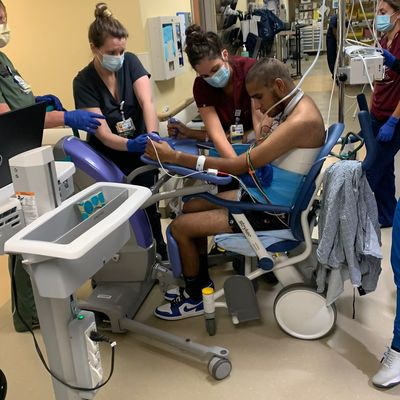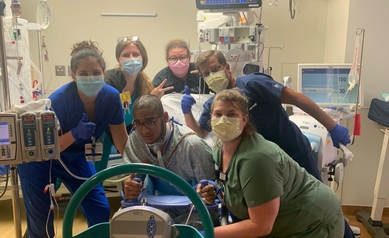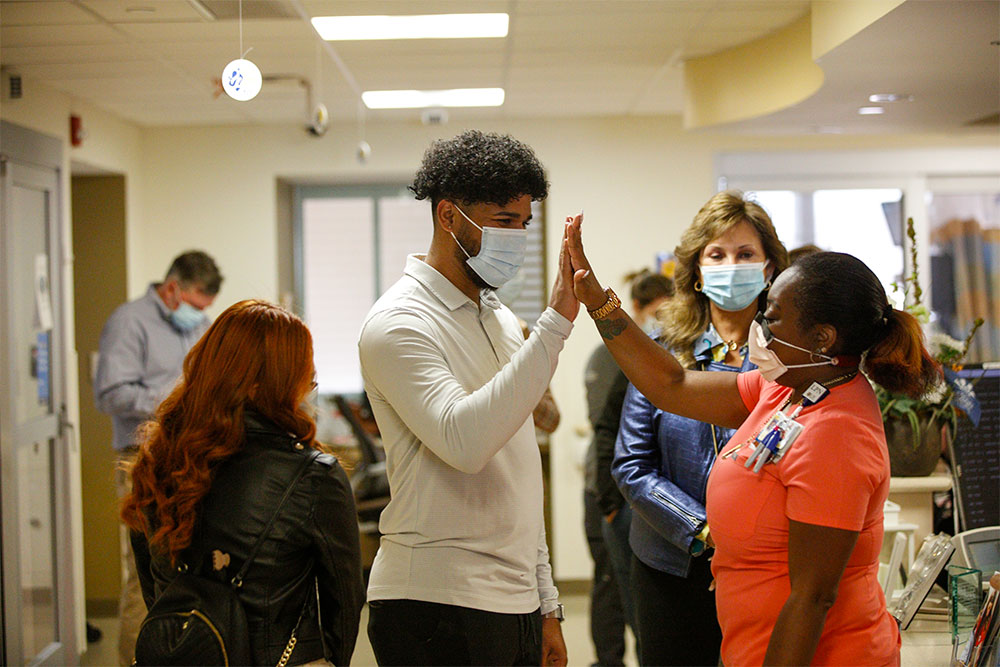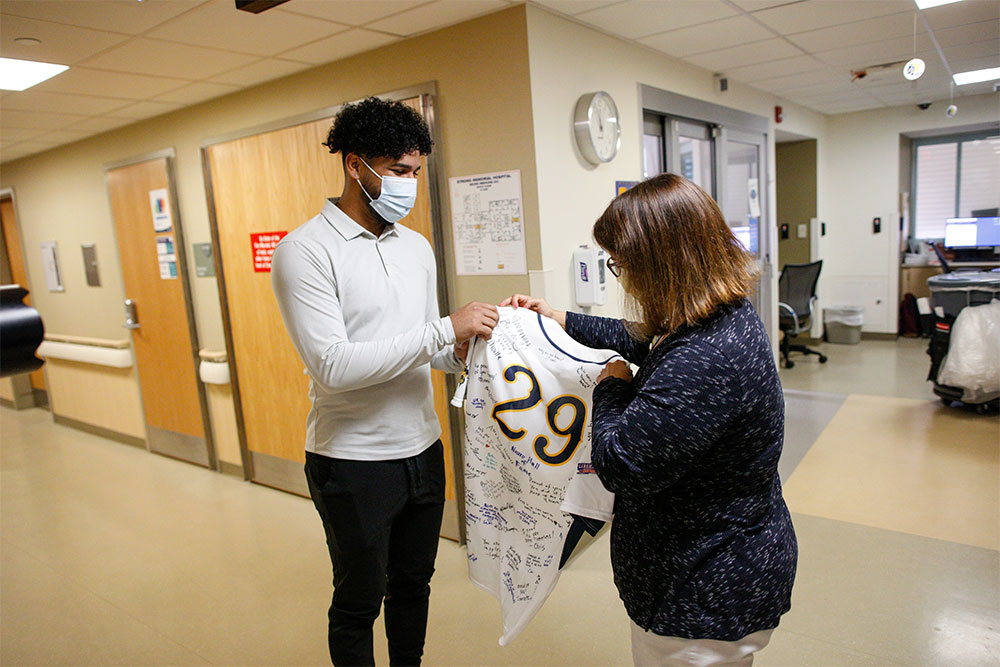 On July 31 last year, Daniel Brito, third basemen for the Lehigh Valley Iron Pigs, had just taken the field in the bottom of first inning during the first game of a planned double header against the Rochester Red Wings when the unthinkable happened. A tangle of abnormal blood vessels – called an arteriovenous malformation (AVM) – burst in his brain and triggered a seizure. Brito collapsed in the infield, the game was halted, an ambulance was brought onto the field, and he was rushed to UR Medicine’s Strong Memorial Hospital.
On July 31 last year, Daniel Brito, third basemen for the Lehigh Valley Iron Pigs, had just taken the field in the bottom of first inning during the first game of a planned double header against the Rochester Red Wings when the unthinkable happened. A tangle of abnormal blood vessels – called an arteriovenous malformation (AVM) – burst in his brain and triggered a seizure. Brito collapsed in the infield, the game was halted, an ambulance was brought onto the field, and he was rushed to UR Medicine’s Strong Memorial Hospital.
While those frightening scenes at Frontier Field were reported by the media, the full story of what occurred that day and Brito’s remarkable journey to recovery from a dangerous and potentially deadly brain injury is only now being fully told in a story appearing in The Athletic.
“Everything that happened to Daniel felt like it was one in a million,” said Debra Roberts, M.D., the director of the UR Medicine Neuromedicine Intensive Care Unit which was Brito’s home for almost two months as he recovered from the damage caused to his brain. “A million in one chance he is born in Venezuela and becomes a professional baseball player. And a million in one chance that he both has an AVM and that it ruptures.”
AVMs are rare, can form at a very young age, and frequently go undetected until it triggers dizziness, headaches, or seizures, which result in the AVM being identified in brain scans and medically managed or surgically removed. While ruptures are rare, occurring in roughly two percent of people with an AVM annually, the consequences can be severe, both in terms of damage to nearby brain tissue, but also the pressure that the bleeding and buildup of fluids puts on the brain. The stress response triggered in the body can also sometimes lead to complications with other organs as the body fights for survival.
Brito was transported to Strong Memorial Hospital and CT scans identified the location of the hemorrhage and the ruptured blood vessel. A surgical team led by neurosurgeon Thomas Mattingly, M.D., operated on Brito later that day, stopped the bleeding, and removed fluid that had built up in his brain. The surgeons left off a section of Daniel’s skull and inserted a drain to further relieve pressure on his brain.
Reflecting on Brito’s case, Mattingly and Roberts noted that he had a few factors in this favor. He was young and in otherwise good health and the rupture took place close to the surface of the brain in the frontal lobe, which made it more accessible to surgeons compared to ruptures that occur deeper in the brain tissue.

Daniel Brito and his team in the URMC Neuromedicine ICU
But brain injuries are unpredictable. After surgery, Brito was placed in a weeks-long medically-induced coma to manage his blood pressure and prevent more bleeding in his brain. During his time in the Neuro-ICU, he also developed acute respiratory distress syndrome (ARDS). This condition sometimes occurs in patients who have experienced a catastrophic brain injury. While not entirely understood, it occurs when immune cells in the lungs become over-activated, triggering dangerous inflammation in the lungs.
The medical team in the Neuro-ICU had to carefully balance the need to give his brain time to recover, while at the same time keeping fluid out of his lungs and ensuring he was getting enough oxygen. Managing both these conditions at the same time requires intense round-the-clock care and monitoring. On one occasion, the team came close to putting Brito on advanced life support, which could have slowed his recovery, but this was ultimately avoided.
By August 20, Brito was stable enough for a second operation which allowed surgeons to permanently seal off the rupture site. After surgery, the Neuro-ICU team began to slowly wake him from the coma. By the end of September, he was up and walking and playing catch with his family and ICU staff. After 59 days in Strong Memorial Hospital, Daniel was discharged into the care Moss Rehab in Philadelphia, in part to be closer to the Philadelphia Phillies medical staff. The Iron Pigs are the Triple-A affiliate of the Phillies.
The Athletic piece details Brito’s road to recovery since he left Rochester. Like everyone who has suffered from a major brain injury, Mattingly and Roberts are aware that Brito still has challenges ahead of him as his brain continues to heal, but the fact that he has returned to baseball activities six months after the incident is “remarkable.”
“The surgeries and his time in the ICU under high level maintenance during which almost all of his bodily functions are assisted through mechanical means, these are all aggressive measures of care,” said Mattingly. “But in the right situation it pays off to be aggressive and in Daniel’s instance you had a young person with real potential of recovery and the potential to continue to get better over time. If this had occurred in an older person, the outcome would very likely have been different.”
The piece also details how the Phillies, Rochester Red Wings, and local organizations rallied to support Daniel, his fiancé Anyelis Petit, and his family, who were brought up from Venezuela and spent weeks in Rochester while Daniel was in the hospital.
“I can speak on behalf of the neurosurgeons, neurologists, critical care nurses, and staff involved in Daniel’s care and say it was a privilege to be a part of his remarkable story,” said Roberts. “Not only the outcome, but the way that the medical team, his family, professional baseball, and our community came together to bring him to this point is experience I will never forget.”

Brito returns to visit with the staff who saved his life.

Brito is presented with a UR baseball jersey signed by URMC staff.
Experience Daniel’s story
Daniel Brito, third baseman for the Leigh Valley Iron Pigs, collapsed during a planned doubleheader against the Rochester Red Wings. Rushed to Strong Memorial Hospital, he was diagnosed and quickly treated for a ruptured blood vessel in the brain. Daniel’s recovery from this devastating brain injury was possible because of the advanced surgical and ICU care he received during his 3-month long stay at the hospital.
—Story by Mark Michaud, February 14, 2022


